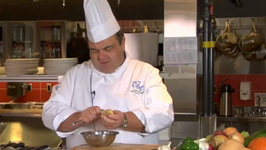Mushrooms 101 - Produce Made Simple
Mushrooms deliver a lot of flavour for just a few calories. There are a wide variety of these earthy tasting gems to choose from: the most popular and commonly used varieties can be found at most grocery stores. Different types of mushrooms will boast different complexities in flavour: some have more umami, some seem to melt away as you eat them while others have a hearty and meaty texture. Try them all to see which ones you like best!
What to look for when selecting:
Select fresh, firm, even-shaped mushrooms with no bruises or visible moisture on the outside. Avoid slimy mushrooms. Selecting mushrooms that are close to the same size will ensure similar cooking times.
If buying packaged mushrooms, check to make sure there is no excess moisture inside the package.
How to store:
Packaged mushrooms keep well in the refrigerator, but once opened they should be transferred and stored in a brown paper bag as they will breathe better and stay firm longer. Mushrooms are best when used within a few days of purchase, but can be kept in the fridge for up to one week.
How to prepare:
Clean mushrooms just before you are about to use them. To clean them, gently brush away the dirt with a soft brush or wipe with a damp paper towel and trim any stem ends.
Contrary to the myth that you cannot wash mushrooms, if theyre really dirty, you can give them a quick rinse in cold water and pat dry. Soaked mushrooms may add a small amount of water but theyre already high in water content so cleaning them doesnt make too much of a difference. The most noticeable difference is that it may take an extra minute or two for the mushrooms to release their juices before they start to brown.
If you are cooking with Shiitake mushrooms, remember that they have a tough stem that needs to be removed. Other mushroom varieties typically have tender stems and can be left intact. After being cleaned, mushrooms can be chopped, sliced, grated, torn or left whole. Mushrooms can be enjoyed raw or cooked.
Varieties:
White Button Mushrooms:
White mushrooms are the most popular mushrooms in Ontario. The colour of these mushrooms varies from bright white to a light brown. White mushrooms are available in three different sizes: small buttons, medium and large jumbo.
Best Cooking Methods: Serve in soups, salads, appetizers, and entrées.
Cremini Brown Mushrooms:
Similar to the white mushroom in shape and size but firmer to the touch. These mushrooms have a dark cap that ranges from a light tan to rich brown.
Best Cooking Methods: Serve in soups, salads and entrées. These are a great substitute for white mushrooms.
Portabella Mushrooms:
Portabellas are fully grown Cremini mushrooms with a large light tan cap. Growing up to 6 inches (15cm) across, it is a larger relative of the White and Cremini mushroom. Portabellas are the largest of all domestic mushrooms.
Best Cooking Methods: Can be grilled or baked and used in appetizers, side dishes and entrées. Portabellas are great meat substitutes because of their natural umami/meaty flavour.
Shiitake Mushrooms:
Shiitake mushrooms range in colour from tan to dark brown. They have umbrella shaped caps, 2 to 4 inches (5 to 10 cm) in diameter, with open veils and tan gills.
Best Cooking Methods: Shiitake mushrooms are most commonly used in stir-fry and pasta dishes.
Oyster Mushrooms: Oyster mushrooms have a light to dark brown funnel or fluted cap, which ranges in size from 1 to 4 inches (2.5 to 10 cm). It has whitish yellow gills running up a short off-centre stem.
Best Cooking Methods: Because of the velvety texture of the Oyster mushroom, they make a great compliment to dishes featuring chicken, seafood and pork.
Enoki Mushrooms: Enoki mushrooms have long, slender white stems with tiny firm caps.
Best Cooking Methods: Enoki mushrooms are commonly used in Asian dishes but are also suitable for salads, soups, sandwiches and pasta.
Tips:
- Mushrooms are a natural source of Vitamin D. Instead of buying expensive Vitamin D supplements, you can instead add a serving of mushrooms to your daily food intake.
- Did you know that Mushrooms are grown year-round in Canada? This is because mushrooms are grown in the dark in climate-controlled buildings. The ideal growing conditions for mushrooms (dark, humid and damp) are kept constant in these buildings throughout the entire year. Therefore, local production and harvesting of the six varieties of fresh mushrooms occurs year round.
- It is recommended that you enjoy dried mushrooms within one year.






















